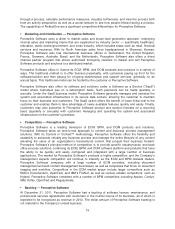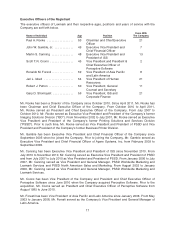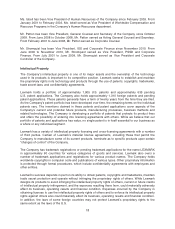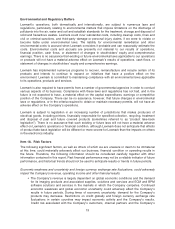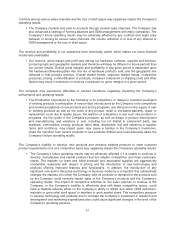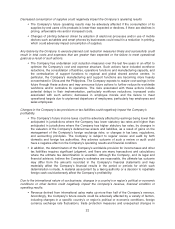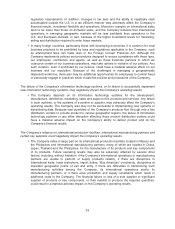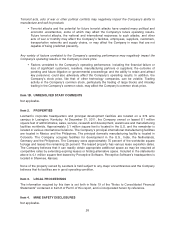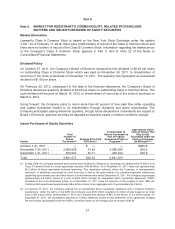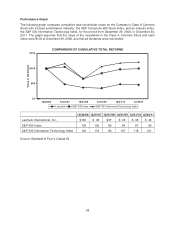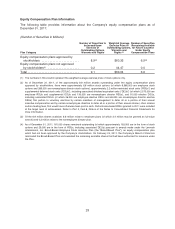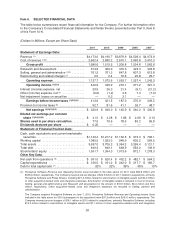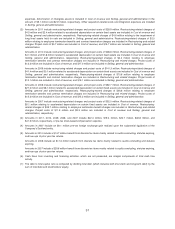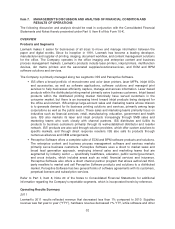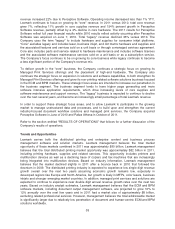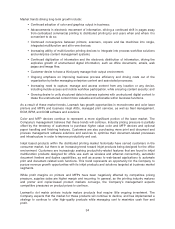Lexmark 2011 Annual Report Download - page 29
Download and view the complete annual report
Please find page 29 of the 2011 Lexmark annual report below. You can navigate through the pages in the report by either clicking on the pages listed below, or by using the keyword search tool below to find specific information within the annual report.Increased competition in the Company’s aftermarket supplies business may negatively impact the
Company’s revenue and gross margins.
• Refill, remanufactured, clones, counterfeits and other compatible alternatives for some of the
Company’s cartridges are available and compete with the Company’s supplies business. The
Company expects competitive supplies activity to increase. Various legal challenges and
governmental activities may intensify competition for the Company’s aftermarket supplies
business.
New legislation, fees on the Company’s products or litigation costs required to protect the Company’s
rights may negatively impact the Company’s cost structure, access to components and operating results.
• Certain countries (primarily in Europe) and/or collecting societies representing copyright owners’
interests have commenced proceedings to impose fees on devices (such as scanners, printers
and multifunction devices) alleging the copyright owners are entitled to compensation because
these devices enable reproducing copyrighted content. Other countries are also considering
imposing fees on certain devices. The amount of fees, if imposed, would depend on the number
of products sold and the amounts of the fee on each product, which will vary by product and by
country. The financial impact on the Company, which will depend in large part upon the outcome
of local legislative processes, the Company’s and other industry participants’ outcome in
contesting the fees and the Company’s ability to mitigate that impact by increasing prices, which
ability will depend upon competitive market conditions, remains uncertain. The outcome of the
copyright fee issue could adversely affect the Company’s operating results and business.
The Company’s inability to obtain and protect its intellectual property and defend against claims of
infringement by others may negatively impact the Company’s operating results.
• The Company’s success depends in part on its ability to develop technology and obtain patents,
copyrights and trademarks, and maintain trade secret protection, to protect its intellectual property
against theft, infringement or other misuse by others. The Company must also conduct its
operations without infringing the proprietary rights of others. Current or future claims of intellectual
property infringement could prevent the Company from obtaining technology of others and could
otherwise materially and adversely affect its operating results or business, as could expenses
incurred by the Company in obtaining intellectual property rights, enforcing its intellectual property
rights against others or defending against claims that the Company’s products infringe the
intellectual property rights of others, that the Company engages in false or deceptive practices or
that its conduct is anti-competitive.
The inability to attract, retain and motivate key employees could adversely affect the Company’s
operating results.
• In order to compete, the Company must attract, retain, and motivate executives and other key
employees, and its failure to do so could harm the Company’s results of operations. Hiring and
retaining qualified executives, engineers, technical staff, sales, marketing and IT support positions
are critical to the Company’s business, and competition for experienced employees in our industry
can be intense. To help attract, retain, and motivate qualified employees, the Company must offer
a competitive compensation package, including cash, cash-based incentive awards and share-
based incentive awards, such as restricted stock units. Because the cash-based and share-based
incentive awards are dependent upon the performance conditions relating to the Company’s
performance and the performance of the price of the Company’s common stock, the future value
of such awards are uncertain. If the anticipated value of such incentive awards do not materialize,
or if the total compensation package ceases to be viewed as competitive, the Company’s ability to
attract, retain, and motivate employees could be weakened, which could harm the Company’s
results of operations.
25


